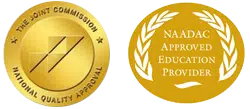Mental illness and addiction are closely related in that one condition can often trigger the other. A person with both conditions can benefit from having them treated simultaneously to reduce the risk of drug and alcohol relapse, and to improve their mental and physical health. Dual diagnosis therapy is usually included in most drug and alcohol rehab programs to help people recover from both substance use disorders and mental illness.
What Is a Co-Occurring Disorder?
In the context of addiction, a dual diagnosis, also known as co-occurring disorders, is the diagnosis of both a substance use disorder and a mental illness. Substance use disorders and mental illness tend to occur together because one condition can often easily lead to the development of the other.
For instance, a person who suffers from a mental illness may use drugs and alcohol in hopes of making their symptoms go away and to make themselves feel better. On the other hand, a person who uses drugs and alcohol regularly in high amounts can damage their brains and suffer major chemical imbalances that contribute to mental illness. Substance use disorders and mental illness also share many of the same risk factors including stress, trauma, and genetics that increase the likelihood of suffering from both disorders when these risk factors are met.
How Prevalent Is Dual Diagnosis?
The National Library of Medicine reports that an estimated 50% of people who have a mental illness will also have a substance use disorder at some point in their lives, and vice versa. In a 2018 survey conducted by SAMHSA, researchers found that approximately 9.2 million adults in the U.S. have a dual diagnosis.
A dual diagnosis can be a combination of any type of substance use disorder and mental illness, though certain addiction types and mental illnesses are more common than others in a dual diagnosis.
When observing co-occurring disorders among patients in medication-assisted treatment programs, researchers noted that the most common mental disorders were:
- Anxiety disorders
- PTSD
- Schizophrenia
- ADHD
- Bipolar disorder
- Major depressive disorder
- Conduct disorders
Additionally, the following substances were commonly abused among patients with co-occurring disorders:
- Alcohol
- Tobacco
- Opioids (e.g., heroin, fentanyl, methadone)
- Stimulants (e.g., methamphetamine, cocaine, amphetamine)
- Marijuana
- Hallucinogens (e.g., LSD, PCP, ketamine)
- Prescription drugs (e.g., benzodiazepines, painkillers, sleep medications)
How Are Co-Occurring Disorders Diagnosed?
Mental health disorders can sometimes be difficult to diagnose in those with substance use disorders, mainly because symptoms of drug and alcohol withdrawal are synonymous with those of mental illness. For instance, anxiety and insomnia are symptoms of both depression and opioid withdrawal. According to the National Institute on Drug Abuse (NIDA), patients who are treated at drug rehab centers are often closely observed after drug and alcohol detox to distinguish between the effects of withdrawal and symptoms of mental illness. Some patients may not be officially diagnosed with co-occurring disorders for several weeks following drug and alcohol withdrawal.
Addiction treatment centers will usually perform a thorough medical assessment and evaluation on patients at the time of intake, during which they learn whether mental illness is in a patient’s medical history. Some patients with a history of mental illness are upfront with their clinicians and psychologists about their mental health before beginning drug detox or behavioral therapy.
How Is Dual Diagnosis Treated?
Dual diagnosis can be effectively treated with medications and behavioral therapy, reports the NIDA. Patients with dual diagnosis may receive one or more behavioral therapies—all of which can be tailored to various factors including the patient’s age, the substance being used, and the root cause of the addiction.
Examples of behavioral therapies that may be used to treat dual diagnosis include:
- Cognitive-behavioral therapy, which helps patients change harmful beliefs and behaviors related to substance abuse and mental illness.
- Assertive community treatment, which places emphasis on community outreach.
- Therapeutic communities, which are long-term residential treatment programs that focus on resocializing patients.
Medications used to treat dual diagnosis include those effective at treating addiction to opioids, alcohol, and nicotine, as well as symptoms of mental illness. For instance, the NIDA states that bupropion may be used to treat patients with a dual diagnosis of depression and methamphetamine addiction. In many instances, medications may be used to treat the mental illness, while behavioral therapy may be used to treat the psychological aspects of the substance use disorder.
When researching addiction treatment options for yourself or a loved one, look specifically for drug rehab centers that offer dual diagnosis therapy. Even if you’re not sure whether you or your loved one has a dual diagnosis, choosing a drug rehab center that offers this treatment can ensure you or your loved one have a greater chance at achieving long-term recovery.



